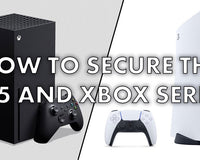Since the dawn of gaming, the most popular form of hardware to play on has been PC. From predicting astronomical positioning to targeting ships underwater to calculating 2+2, advancements in computers have come a long way. To this day, tech companies continue to find ways to enhance the experience that comes from using their peripherals. A great example of this comes to us from Valve Corporation in the form of the Steam Deck: a handheld gaming computer that can play hundreds of PC games on the go or at home on any monitor. It has been at the forefront of portable PC units since it debuted in February 2022. Though there are many like it on the market right now, none have held a candle to the Steam Deck's popularity... until now. Enter the ASUS ROG Ally.
ASUSTek Computer Inc., more commonly known as ASUS, released their answer to the Steam Deck just a few months ago in June 2023 and it is gaining serious traction in popularity --- at least in its subcategory of gaming consoles. Is the ROG Ally truly a heated rival of the Steam Deck or is it David versus Goliath of on-the-go units? Let's take a look at some key elements of both consoles.

WHERE TO BUY
The Steam Deck can only be purchased through Valve's website whereas the ROG Ally is exclusive to Best Buy. If you're old school like me and actually want to see the tech you're buying in person, it's nice to have the option with ASUS. The brick and mortar route is obviously less time to get your hands on it, too, as Valve promises up to two weeks in shipping.
EDGE - TIE: Both sides have the convenience of online ordering and in today's economy, the in-store availability neither helps nor hinders the Ally.

MODELS & PRICE
Currently, the Steam Deck has three models available. The base model with 64 GB of eMMC storage starts at $499 CAD / $399 USD. Their higher end models both feature SSDs for faster loading times than the base. The 256 GB version goes for $659 CAD / $529 USD and the 512 GB costs $819 CAD / $649 USD.
The ROG Ally presently only has one model since its launch, a 512 GB SSD with an AMD Ryzen Z1 Extreme chip, priced at a whopping $900 CAD / $700 USD. ASUS has said that there will be a second, lower end model releasing later this year for about $800 CAD / $600 USD that features a 256 GB SSD and a standard Ryzen Z1 processor.
EDGE - STEAM DECK: Valve offers more options with a more affordable base unit. Even their best of three models is cheaper than the ROG Ally's sole system. PC gamers already spend a fortune on just the basics for their setups, so saving money wherever possible is the smarter option.

WEIGHT
Given that our two contenders are both primarily used in handheld mode, their weight can make a difference when players are using them for hours on end. The Steam Deck weighs in at 1.48 lbs, whereas the ROG Ally touts a weight of 1.34 lbs. A small variance, for sure, but it can make all the difference if you were traveling long distance with it. Not only is the Ally lighter, but it is also narrower than the Deck. The ROG Ally measures 11.02 inches wide, with the Steam Deck width being 11.7 inches across.
EDGE - ROG ALLY: The ASUS machine is lighter, making it more ideal for longer handheld gaming sessions. It also takes up less space, so if you were to store it in a backpack or suitcase, it would free up extra room for other accessories.

DISPLAY
Despite the difference in physical size, they both feature 7-inch IPS touch displays, but with the Ally boasting a 1920x1080 resolution display over Steam's 1280x800. The Ally's refresh rate is twice as smooth as the Steam Deck clocking in at 120Hz and 60Hz, respectively; however, the Deck can output up to 8K, with the Ally only doing 4K.
EDGE - ROG ALLY: The R.A. has a more visually appealing display than the Valve equivalent. Smoother graphics wins over higher resolution because on such a small screen, a couple extra K's won't be as noticeable as something like motion blur.

BATTERY
If you're looking to run your games at the best possible settings, be prepared to sacrifice battery life. The Steam Deck's average playtime of AAA games clocks in at around two hours. The ROG Ally lasts a little less time at about 90 minutes. Valve and ASUS both claim the battery life is closer to eight hours, but it's safe to assume that applies more to indie games that are less demanding of the hardware.
ASUS has claimed that the ROG Ally could offer double the performance of the Steam Deck while running at a wattage of 30W. The math on this adds up as the Steam Deck uses around 15W, but the higher wattage from the Ally would take a big chunk out of the already short battery life. The high refresh rate on the ROG Ally is also a major contributor to the shorter play time.
EDGE - STEAM DECK: Two hours may not be a very long time, but the lesser of two evils wins in this category. Even if you play on the lowest settings, the Steam Deck still uses less power overall.

OPERATING SYSTEMS
The largest factor to consider between these two choices is what game libraries are accessible. What good is a gaming PC with no games to play? The Steam Deck natively runs SteamOS, and includes a feature called Deck Verified. This verification indicates whether a specific game can be played on the Steam Deck in handheld mode.
Though the ROG Ally doesn’t have anything to indicate whether a game is even playable on the hardware, it does have a greater number of launchers to choose from. Because its base operating system is Windows 11, not only can it launch SteamOS, but also games from the Epic Games Store, Xbox Game Pass for PC, and a myriad of other platforms that can be run on a standard PC. The tech savvier of us could technically get Windows 11 onto the Steam Deck, but it would take away precious game time just to figure out how. Don’t write off Steam just yet, because the touchscreen features are a much smoother experience than on the Ally, as Windows 11 isn’t optimized for touchscreen.
EDGE - ROG ALLY: Most users are probably not utilizing the touchscreen features to their full extent, so trading that quality off for a wider variety of games makes the most sense. Though the Deck Verified tag is a nice addition to prevent buyer’s remorse, it’s nothing a quick search online couldn’t answer.
OTHER FEATURES
As much as they are different, the Steam Deck and ROG Ally share some similarities in some basic areas that are still worth mentioning. The controller layout is nearly identical. Both have the Xbox-style face buttons (ABXY), left and right bumpers and triggers, a D-Pad, and two analog sticks. The latter component is off-axis on the Ally and parallel on the Steam Deck. A small difference, but to some it can mean everything. There are also programmable buttons on the backsides, two for the Ally and four for the Steam Deck.
Both include a dock that can be used to connect them to TV screens or monitors, similar to the Nintendo Switch. Finally, both devices have gyroscope capabilities for motion controls. ASUS’s, however, is not currently active yet, but will be later on in the future.
EDGE - TIE: Not much to say here. Neither handheld has anything drastically advantageous in this category.

FINAL WORDS
After analyzing the two portable gaming computers, the ASUS ROG Ally certainly holds its own against the dominating force of the Valve Steam Deck. The Ally’s sales numbers are no small feat, as they have sold around 500,000 units in just its first month. The Steam Deck is looking to cross 3 million units by the end of its second year, a feat which ASUS could accomplish in a quarter of the time if their sales trend continues. The technical specifications, though similar, steer us more towards the Ally, but with the mainstream staying power that Steam has had over the years, it makes it tough to replace.
What do you think? Is it all hands on Deck? Or are you an ally of the Ally? Let us know in the comments! If you want to protect or store your Steam Deck like a pro gamer, be sure to check out the Glistco Shop Steam Deck Collection for all your accessory needs!







4 comments
Ray
Well I just returned my steam deck oled, and got the Ally extreme, and I love the ASUS! Been playing warzone, and multiplayer. So impressed with the performance.
Miguel sanchez
WHY DOES EVERYONE THINK THE ASUS ROG ALLY IS A OLED SWITCH
Miguel sanchez
WHY DOES EVERYONE THINK THE ASUS ROG ALLY IS A OLED SWITCH
Miguel sanchez
WOOOOOOOOOOO, ALLY TO THE ALLY!!!!!!!!!!!!!!!!!!!!!!!! LETS GOOOOOOOOOOOOOO